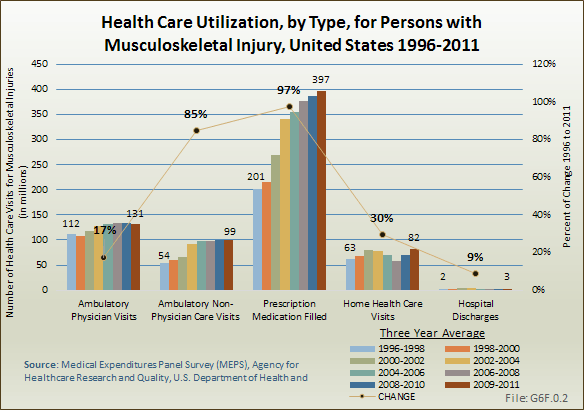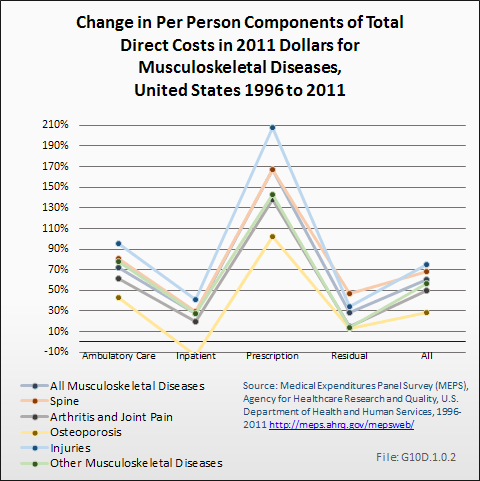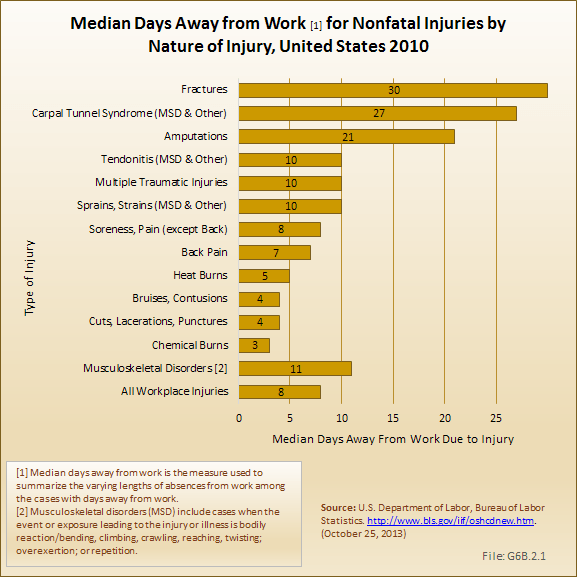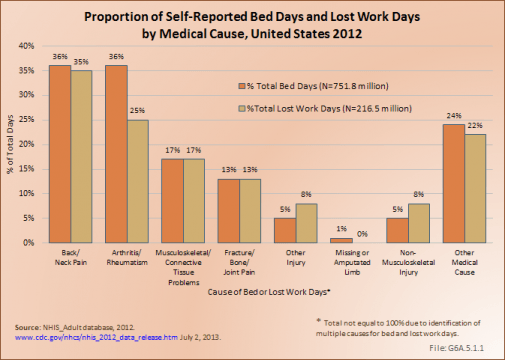Bridging the Wellness Gap
It was heartening to hear local company reports of the favorable trend of increased employee participation in wellness programs at the “Phoenix Business Journal’s Healthiest Employers” event. Notwithstanding arguments of hard ROI versus soft returns regarding employee satisfaction and productivity, “wellness” clearly benefits both the employers and individuals.
While nutrition and exercise programs help to improve blood sugar levels, blood pressure, and body mass index, a significant gap in wellness remains for both businesses and their employees who cannot participate in wellness programs due to a factor which accounts for 33% of all work-related illnesses and injuries. The elephant in the wellness room is chronic pain.
Perhaps it’s time to expand wellness to a deeper level and address the largest category of chronic medical conditions accounting for the greatest loss of productivity, absenteeism, health-care costs, and a significant portion of worker’s compensation claims – Musculoskeletal Disorders (“MSDs”).
The Leading Cause of Disability/Health Care Cost
The prevalence of MSDs and their related costs are sobering. One in two or 126.6 million1 adults are affected by MSDs. That’s twice the rate of those with chronic heart and lung conditions, and seven times the 18.8 million diagnosed with diabetes.

It’s hard to be productive, or participate in a company challenge or make the best food choices when it’s painful to even think or move. How many employees might choose to participate or stay engaged if pain and/or mobility issues didn’t stop them? How much more productivity, focus, and satisfaction might employees have if chronic pain, tension or stress wasn’t distracting them from work or keeping them absent from it?
What are Musculoskeletal Disorders?
“Musculoskeletal Disorders” encompass conditions and injuries related to the bones, joints, muscles, tendons, ligaments, and connective tissue (also known as fascia).
The most prevalent musculoskeletal conditions are:
- Back & Neck disorders, disc disorders, and injuries
- Arthritis & Joint Pain
- Osteoporosis
- Injuries
The National Impact of MSDs
The overall cost for MSD treatment and lost wages is a staggering $874 Billion2 which constricts businesses, employees, and society-at-large. Already equaling 5.7% of GDP in 2011 dollars3 and rising, it wouldn’t be an overstatement to say that musculoskeletal disorders are one of the leading determinants of the physical and economic health of our nation.
Narrowing the Scope
Setting aside the categories of acute and chronic bone issues (such as fractures, arthritis, osteoporosis, skeletal and disc disorders) and the acute stages of torn ligaments or tendons requiring surgery, leaves soft tissue disorders and injuries open for discussion.
Looking at the $176.9 Billion4 spent from back, neck, and musculoskeletal injury subcategories compared to the overall, current U.S. health care costs pointing toward a trillion, might, at first glance, seem like small potatoes.
To the contrary, these subcategories are significant for two reasons: the scope of their impact and the fact that they have the greatest potential for positive change.
The Impact of Musculoskeletal Injuries5:
77% (65.8 million) – Leading cause of all injury-related health care visits
$176.9 Billion – Annual cost of treatment (2011)
397 Million – Number of prescriptions filled for MSDs (2011)
70% (216.5 million days) – Self-reported lost work days due to MSDs
30% (284,000) of work-related injuries due to MSDs with an average of eleven lost work days
Compounded Pain for Business
For employers, the economic burden from lost work days is compounded by two other factors. First, the price of absenteeism and lost productivity estimated to be $225.8 Billion or $1,685 per employee6. Second, when the multi-year economic impact of increased worker’s compensation insurance premiums triggered by 7+day claims is added in, it’s easy to understand why U.S. businesses are struggling.
Traditional Treatment
MSDs are traditionally treated with rest, over-the-counter or prescription drugs, and/or surgery. Before addressing other components, the overriding socioeconomic component of accelerated increase in prescription drug treatment for MSDs needs to be recognized.
The Rise of Prescription Drug Treatment for Musculoskeletal Disorders

Of all direct cost component use, the 97% increase in filled prescriptions for MSDs is largest.
While the direct costs for all MSDs treatment components have increased, none compare to the 210% increase of prescription drugs.

The greater socioeconomic cost and consequence, yet to be fully measured, is the opioid addiction epidemic resulting from the increased number of prescriptions being written for them. From absenteeism to rehabilitation, opioid addiction is a very real burden contributing to declining productivity and rising health care costs.
Unfortunately, the impact doesn't end there. The grave reality of soaring deaths due to opioid overdose is most recently seen in this week's proclamation by Governor Ducey of a statewide health emergency for Arizona. For more discussion on the epidemic, see The Price of Pain series.
Having access to and implementing alternative pain relief options provides exponential benefit for employers, individuals, and the society-at-large.
Lost Work Days by Nature of Injury
Let’s look at injury nature and median days lost, while conservatively focusing on the soft tissue-related or slow onset conditions from the table below.
- Carpal Tunnel Syndrome – twenty-seven days
- Tendonitis – ten days
- Sprains & Strains – ten days
- Soreness & Pain – eight days
- Back Pain – seven days
- Workplace Injuries – eight days (includes soft tissue conditions)
- Musculoskeletal Disorders - eleven days (includes soft tissue conditions)
Each of the above categories hits or crosses 7 days away from work, negatively impacting workers’ compensation insurance ratings. The good news: they are also the categories with greatest opportunity to reduce the number of days away, as well as average cost per hospital stay.

The 2011 average charge per hospital stay for the Sprains and Strains and Musculoskeletal Disorders categories: $41,700 and $48,100, respectively. 7

By percentage above, back and neck pain at 35% and musculoskeletal and connective tissue conditions at 17% account for over half of all lost work days.
Finding a different solution to address the underlying causes of MSDs and mitigate the number of incidents, treatment costs, and lost days is the key to shifting the tide of our current economic and physical health and our overall well-being.
Addressing the above-listed and many other soft-tissue disorders is the segment of health-care where the potential for prevention, faster healing, cost reduction and increased productivity is not only greatest, it is already a reality.
Alternative Methods Sought
The fact that the average number of non-physician care visits for MSDs has increased 92% from 197.5 million visits in 1996 to an average of 379.3 million in 20118 attests to the public’s active pursuit of alternative treatments. And for good reason.
Musculoskeletal disorders respond favorably to the hands of skilled therapists; ones who understand and partner with the self-healing mechanisms already built into the neuromuscular-fascial system. Pain relief and restored mobility can be achieved without the systemic side effects of pharmaceuticals.
The Wellness Bridge - A Different Solution
Even though it has been traditionally studied and applied by professionals, the knowledge of how to partner with the body is not exclusively the domain of professionals. It’s intrinsic in every body, and available to be used by the average person in order to direct or restore his or her own greater health and well-being.
The term “self-care” encompasses many definitions from pampering oneself to visiting a professional to receive the benefit from their skills. These approaches will always have a fundamental place in one’s good health and well-being arsenal. However, within the body’s built-in intelligence and self-restoring design for movement there exists another level of self-care.
While working with thousands of people and hundreds of therapists over 17 years, it’s been my experience that most MSDs can be cleared utilizing the body’s own ability to reset itself, release chronic pain, restore proper muscular tension and a normal range of motion. Resetting normal tension and force patterns allows more balanced, unimpeded movement. It also reduces negative impact on joints and helps mitigate reoccurrence of the condition or injury.
Through a specific system of intentional movements, the term “self-care” deepens to a therapeutic level that is self-applied. Mindfulness, directed in partnership with innate neuromuscular system intelligence releases the underlying cause of myofascial conditions which were previously treated through office visits and medication.
Currently, wellness programs target the underlying factors of diet and exercise to reduce the correlated health conditions. Their implementation is a good step towards greater health for individuals and business.
Offering a self-care wellness program that targets the underlying cause of soft-tissue conditions and/or injuries to release chronic musculoskeletal pain and restore the body’s normal tone and mobility without drugs or office visits takes “wellness” to a deeper level.
It not only addresses the country’s leading health-care cost and cause of disability, it also bridges the wellness gap for healthier individuals, employers, and our society as a whole.
C1-5, 1-5,7,8 Source: United States Bone and Joint Initiative: The Burden of Musculoskeletal Diseases in the United States (BMUS), Third Edition, 2014. Rosemont, IL. Available at http://www.boneandjointburden.org.
6 Source: CDC, International Monetary Fund
About the Author: Kathleen Gramzay
Kathleen Gramzay, BCTMB is Body/Mind Performance Expert, 20-yr Board Certified Massage Therapist, and Developer of Kinessage® Self Care and Mindful Resilience. Her mission is to empower people to release their stress, chronic tension & pain to live more joyful, productive and healthy lives. If you would like to learn more about Kinessage® Self-Care or the Mindful Resilience programs, contact
Kathleen





